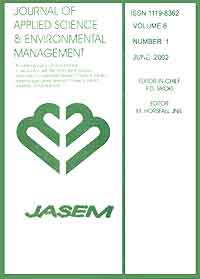
|
Journal of Applied Sciences and Environmental Management
World Bank assisted National Agricultural Research Project (NARP) - University of Port Harcourt
ISSN: 1119-8362
Vol. 20, No. 3, 2016, pp. 691-699
|
 Bioline Code: ja16081
Bioline Code: ja16081
Full paper language: English
Document type: Research Article
Document available free of charge
|
|
|
Journal of Applied Sciences and Environmental Management, Vol. 20, No. 3, 2016, pp. 691-699
| en |
Determination of the Growth Rates of Spirolina  and Cheatoceros Algae in Urban Waste Sewage and their Capability to Deplete Nitrate and Phosphate Content in the Sewage and Cheatoceros Algae in Urban Waste Sewage and their Capability to Deplete Nitrate and Phosphate Content in the Sewage
LAVAJOO, F. & TAHERIZADEH, M.
Abstract
The application of cyanobacterial and diatom cultures for the treatment of
industrial effluents has been well recognized.In this study aimed to evaluate the effect of urban
sewage on growth of Spirolina plantensis and Chaetoceros muelleri. The experiment was
conducted in 6 treatments as a growth medium. Result showed that in treatment 5 maximum cell
densities was (565×102±237.7) at day7 thus treatment 5 has best condition for growth S.
plantensis and in treatment 3 maximum cell density was (825×104±92) at day13.Treatment 5
has best condition for growth C. muelleri. Total chlorophyll a, contents (μg/1) recorded in S.
Plantensi sand C. muelleri was highest at treatment 3(0.21±0.07) and treatment 4(0.23± 0.10)
respectively. In present investigation, both the algal species can be good potential to growth in
urban sewage. The urban sewage removal efficiency of C. muelleri was higher as compare to
S.plantensis which can be recommended for phytoremediation purpose. © JASEM
Keywords
Spirolina; Chaetoceros; Nitrate and phosphate; Chlorophyll a; Urban sewage; Depletion
|
| |
© Copyright 2016 - Journal of Applied Sciences and Environmental Management
|
|
